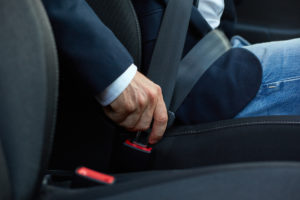 While wearing a seat belt can save your life, there’s no guarantee that you will be completely scratch- after an auto collision. Seat belts are made to keep you in your seat so you don’t get ejected during a car accident. As a result, the rigid strength of the belt restraining you in the car may cause injuries on its own. When you or your driver makes a sudden stop, the speed from the car causes you to hit the seat belt with significant force. That force saves your life, but can leave you with bruises, scrapes and fractures that will need to be treated right away.
While wearing a seat belt can save your life, there’s no guarantee that you will be completely scratch- after an auto collision. Seat belts are made to keep you in your seat so you don’t get ejected during a car accident. As a result, the rigid strength of the belt restraining you in the car may cause injuries on its own. When you or your driver makes a sudden stop, the speed from the car causes you to hit the seat belt with significant force. That force saves your life, but can leave you with bruises, scrapes and fractures that will need to be treated right away.
Here are five of the most common seat belt injuries:
Ribs
Some of the more notable seat belt injuries you can have are bruised or fractured ribs. The restraining force of your seat belt may have enough power to fracture your ribs, and may cause you a significant amount of pain for months. Treat fractured ribs as soon as possible because the dislocated bone could puncture or interfere with your lungs or heart.
Bruised ribs are just as painful as fractured ribs, but without the dislocation. You can treat bruised ribs by icing the area, resting your body and controlling your breathing patterns.
Chest and Sternum
The force from the sudden stop can also affect your chest and sternum region, as it is a direct point of impact with the seat belt. Your sternum is the bone in the middle of your chest that attaches to your ribs. The danger of the injury lies with the fact that your sternum is located near your heart and lungs, so any injury that affects the sternum also affects your organs in that area. If you feel that your chest is sore, seek medical or chiropractic attention to make sure there isn’t a more dangerous problem.
Shoulder
Your seat belt can cause injuries to the soft tissue in your shoulder. The force from the accident can tear the tendons and muscle fibers in your shoulder, which can cause you a great deal of pain and discomfort. Make sure to ice the area to reduce any inflammation, as well maintain a physical therapy routine to restore the shoulder.
Abdomen Soft Tissue
While not always in the immediate area of the seat belt impact, the pressure from the accident can also affect your abdominal region and surrounding organs. Even if you don’t feel pain right after the accident itself, you may have abdominal pain later. By getting an evaluation and treatment, you prevent this pain and discomfort. It also ensures that you won’t have organ problems weeks or months after the accident.
Abrasions and Lacerations
While some seat belt injuries are internal, many affect you externally as well. The roughness of the safety belt and your clothing can rub against your skin and give you painful scrapes and cuts. These scrapes may leave an imprint of the seat belt on your body as the pressure is distributed all over the belt and affects the entire area it touches. Make sure you get your wounds treated to prevent infection from developing.
If you experience any of these injuries after a car accident, make sure you seek chiropractic care in order to treat these conditions.
